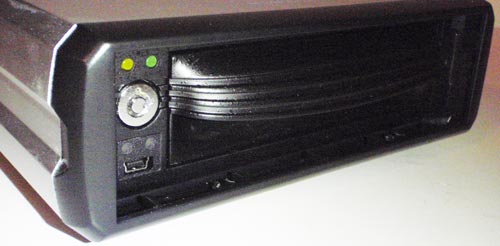
Back in the day, I was in Military Intelligence (no need try, I have heard all the jokes…..). We used some very expensive computer drive technologies to securely store classified materials digitally. This was when storage was measured in kilobytes (maybe megabytes), Photoshop 3 was just released, and a powerpoint presentation fit on a floppy disc. Our computer system (COMPUSEC) regulations required the hard drives be stored in a safe each evening (physical security vs encryption or both). We used hardened removable drives that were clunky, unreliable, and very expensive. So, when I was asked if I would like to try out the DataPort SecureDock from CRU-DataPort the Intel-geek in me got all excited to try this removable hard drive with military-grade encryption.
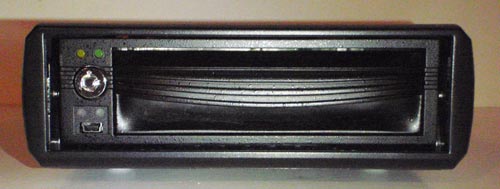
The SecureDock includes a DataPort 10 Secure and the SecureDock housing. CRU-DataPort’s 10 secure caddy is meant to be installed in a desktop’s 5.25-inch bay. But for us laptop users, CRU-DataPort also has the accompanying SecureDock which enables the DataPort 10 secure caddy to act as a hardened, encrypted external hard drive. The DataPort 10 allows you to use any 3.5-inch hard drive; CRU-DataPort has engineered the enclosure to support any SATA drive. The overall build quality of both the caddy and dock are very good, the rugged all-aluminum construction provides great protection and cooling of the hard drive.
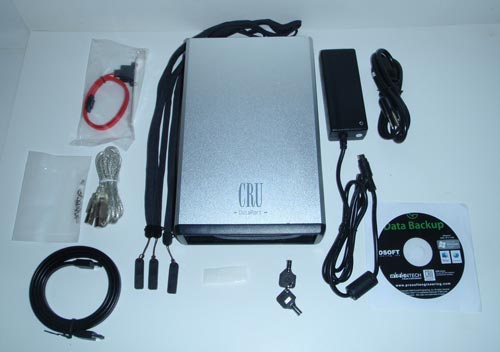
– 1 DataPort frame assembly (SecureDock)
– 1 DataPort carrier assembly (DataPort Secure)
– 1 Power supply
– 1 Metal cover
– 1 USB cable
– 1 Serial ATA cable
– 1 Nylon screw for carrier cover (extra)
– 5 #6-32 x 1/4 flat head screws for drive mounting
– 4 M3 x 5 pan head screws for frame installation
– 3 USB dongles
– 2 Keys for lock
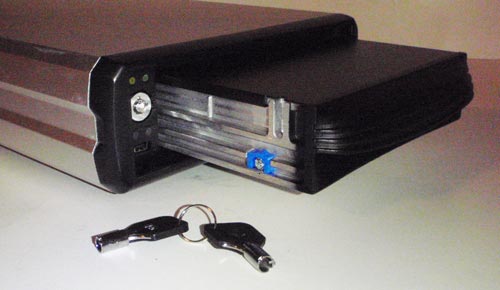
The drive-housing is designed to slide easily into the dock. Both the housing and dock are constructed out of a thick, heavy duty aluminum. CRU-DataPort includes two keys for securing/locking the drive in the bay. The SecureDock is available with no drive, 500Mb, 1Tb, 1.5Tb, and 2Tb hard drives preinstalled.
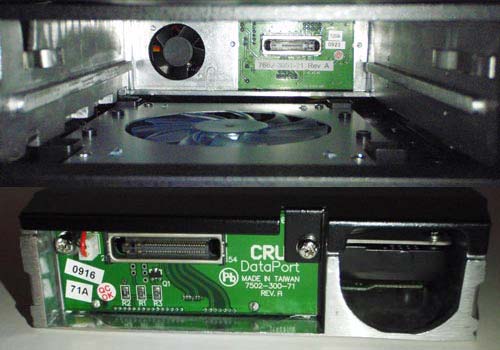
The interconnect appears to be well engineered and is warranted for 30k insertions. You can see there is a fan in the rear of the enclosure and cutout in the back of the caddy; they are engineered to allow warm air surrounding the hard drive to be vented out of the back of the caddy. The only negative I have with the DataPort caddy/SecureDock system is how loud it is. It is the loudest drive/fan I have used in years. Much louder than any other piece of electronics I have in my office. When installed in the 5.25″ bay of a desktop, the DataPort 10 uses the computer’s fans to cool itself and would hopefully be much quieter (depending on how silent your box is).
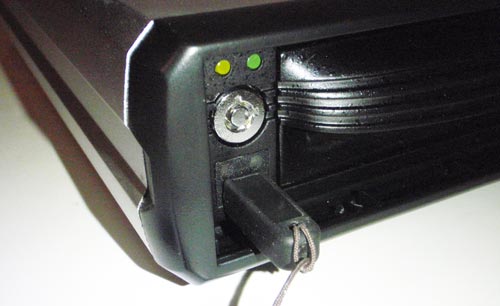
As stated above, the DataPort use military-grade AES (Advanced Encryption Standard) 128-bit encryption (AES 128 is Federal Information Processing Standards (FIPS) approved). To reduce bottlenecking, CRU-DataPort designed the system with a dedicated processor inside the caddy to take care of the encryption and decryption. Instead of managing accessibility within the drive itself or the host system; the DataPort uses a small mini USB dongle (three are included in the box) as the decryption key. The drive is useless unless one of the pre-programmed security keys (USB dongle) is inserted into the USB port on the front of the SecureDock. The system encrypts the entire hard drive, including boot sector, OS, temp and swap files.
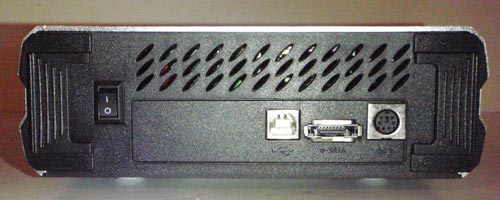
The back of the DataPort looks like many other external hard drives; power, e-SATA (1.5 Gb/sec), USB (480Mb/sec) ports, and a power switch. Funny thing was, the power switch did cause me a bit of confusion. The confusing part was the fact that the switch did not turn off the drive. So, I called CRU-DataPort to find out if I was doing something wrong or received a defective drive. I come to find out, that my review unit was from CRU-DataPort’s first production release, follow on releases do not have the power switch on the back.
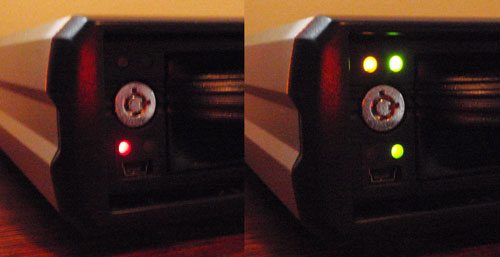
Power is controlled via the lock & key mechanism on the front of the DataPort frame. According to the person I talked with at CRU-DataPort, the logic behind this is that when you power down the drive, the drive should be removed and physically placed in a secure location (due to the fact either the enclosure or computer the DataPort caddy is in could be taken). So, if you went to the nth-degree, your data should incredibly protected….military-grade AES 128 encryption, removing and locking the drive, etc.

CRU-DataPort sell both blank USB keys and an AES Key Programmer which can copy the key from a master dongle to up to four new units.
In today’s day and time, a slow hard drive (encrypted or not) is more or less useless. Thankfully the DataPort has been tested for 3Gb/s full duplex operation, which (according to CRU-DataPort) delivers up to 600MB/s in certain applications. Even with constant encryption going on, the CRU-DataPort drive’s transfer speed is equal to the zippy external Buffalo DriveStation I reviewed last year.
The SecureDock is many times the cost of a typical external drive (ranging from $240 for just the enclosure and DataPort Secure (aka no hard drive) to over $600 for the 2tb SecureDock)….there are definitely less costly data storage options available if you do not need this high level of security. That factor aside, if you do have the need for a portable, secure, encrypted hard drive the CRU-DataPort SecureDock is definitely worth the cost.
Trullypine Laptop Cooling Pad with 12 Quiet Fans, Slim Portable for 12-17.3 Inch Laptop Cooler Stand with 5 Height Adjustable, Ergonomic Gaming Cooling Fan Pad with Two USB Ports & Phone Holder (Gear)
$20.79 (as of December 19, 2025 18:52 GMT -05:00 - More infoProduct prices and availability are accurate as of the date/time indicated and are subject to change. Any price and availability information displayed on [relevant Amazon Site(s), as applicable] at the time of purchase will apply to the purchase of this product.)SwissGear 5505 Cecil 16” Laptop Backpack Cream/Black – Daily Laptop Bag with Gear Attachment Options – Multiple Organizer Pockets & Padded Shoulder Straps
50% OffProduct Information
| Price: | 500mb version is around $300 ($600+ for the 2Tb) |
| Manufacturer: | CRU-DataPort |
| Pros: |
|
| Cons: |
|



Gadgeteer Comment Policy - Please read before commenting
I vaguely recall floppy disks too Dave. Didn’t want you to feel alone.
I have a Lenovo/IBM ThinkCentre desktop with a removable hard drive. Where could I purchase a key to lock and unlcok the drive.
The school that I go to replaced computers and gave us the dead ones.